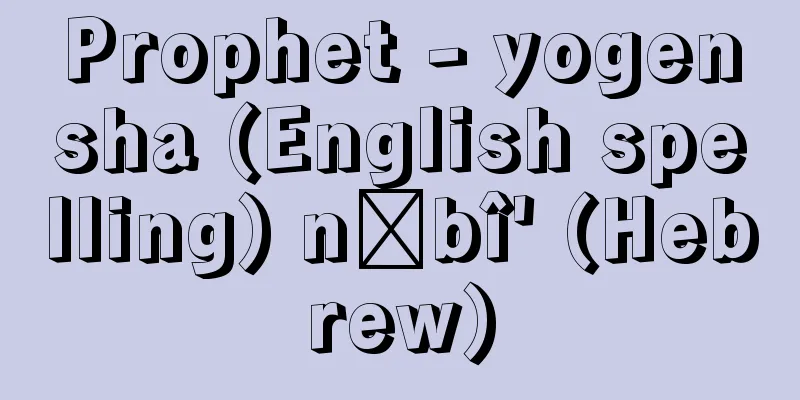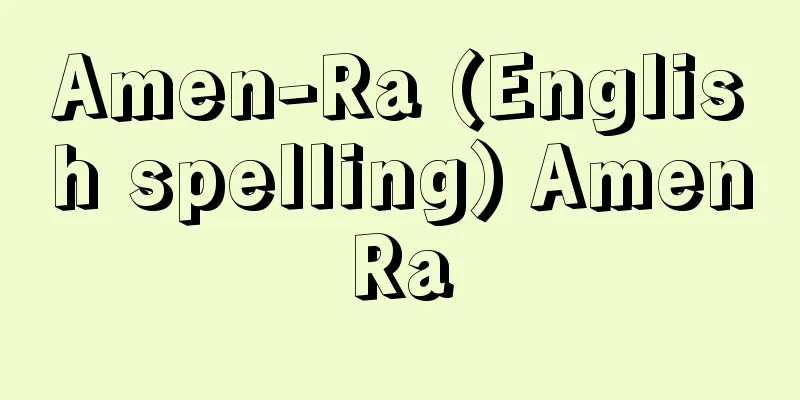Prophet - yogensha (English spelling) nābî' (Hebrew)

|
These are people who point out the content and meaning of the world to come, as well as the attitude and way people should live in relation to it. Religious prophets in Judaism, Christianity, and other religions are representative of this. The Book of Samuel in the Old Testament describes a seer (rō,eh) who had visions while in a state of divine possession and communicated them. In this way, seers have the characteristics of shamans, but when they become prophets (nābî,), they do not simply see and communicate visions, but also speak the words of God that come to the prophet. The distinction between seers and prophets is not always clear within the same Old Testament. What is called the Old Testament in Christianity is the main scripture in Judaism, and is broadly divided into three parts: the Law, the Prophets, and the Writings. The Prophets are further divided into the four books of Joshua, Judges, Samuel (both upper and lower), and Kings (both upper and lower), which are called the Early Prophets, and the Late Prophets, which are the three major prophets, Isaiah, Jeremiah, and Ezekiel, and the twelve minor prophets, such as Hosea, Joel, Amos, Obadiah, Jonah, Micah, Nahum, Habakkuk, Zephaniah, Haggai, Zechariah, and Malachi. Although the "Book of the Prophets" is called a book of prophets, it is more of a history book that records the Israelites who entered the land of Canaan under the leadership of Moses, established the Kingdom of Israel there, and then split into the North and South, and were destroyed, leading to the "Babylonian Captivity." Although seers appear in this work, there are hardly any prophets worthy of the name. Typical prophets are depicted in the "Later Prophets." These prophetic books begin by criticizing the Israelites for going against God's command, worshipping pagan gods and living an unrighteous life, and warn that such a life will bring about the downfall of the nation, and call for recovery from that state. However, the prophets' words are in vain, and when the nation is destroyed and taken captive in Babylon, the prophets begin to encourage the people in their suffering, and speak of the positive meaning that their suffering will have for their future lives. This is the case in chapters 40 to 66 of the "Book of Ezekiel" and the "Book of Isaiah." In particular, the "Song of the Servant of the Lord," found in chapter 53 of the "Book of Isaiah," is known as a prophecy of the coming appearance of Jesus. Thus, prophets are people who are entrusted by God to speak the words of God, especially words that are strongly imbued with ethics. In Judaism and Christianity, Amos, Hosea, Isaiah, Jeremiah, Second Isaiah, and Ezekiel are among the most representative. However, in Islam, Jesus is also considered one of the prophets, and Muhammad is the last and greatest prophet. In Japan, prophetic figures include Nichiren of Kamakura Buddhism, who preached about internal and external troubles in his book Rissho Ankokuron, and Uchimura Kanzo and Yanaihara Tadao of non-church Christianity, who preached about the destruction of Japan through unjust war. What prophets and prophetic figures have in common is their strong vocational experiences and their criticism of the society in which they live, coupled with a sense of the end times. For this reason, they are often persecuted by the world and come into conflict with the priests of traditional religions. Prophets often appear in times of crisis during periods of social change, but prophets and their spirit can also promote situations of change aimed at creating a new society. [Norihisa Suzuki] [References] | | |Source: Shogakukan Encyclopedia Nipponica About Encyclopedia Nipponica Information | Legend |
|
きたるべき世界の内容や、その意味、それに対する人間の態度や生活のあり方を指し示す人たちをいう。ユダヤ教、キリスト教などの宗教的預言者がその代表。『旧約聖書』の「サムエル記」には、神がかり状態のなかで幻を見、それを伝える見者(けんじゃ)(ローエーrō,eh)のことが記されている。見者には、このようにシャーマンの性格がみいだされるが、預言者(ナービーnābî,)となると、ただ幻を見て語るだけでなく、預言者に臨んだ神のことばを語る性格が強くなる。 この見者と預言者との区別は、同じ『旧約聖書』のなかでかならずしも明瞭(めいりょう)にされているわけではない。キリスト教で『旧約聖書』とよばれている部分は、ユダヤ教では主たる聖典であり、「律法」「預言書」「諸書」の3部に大別される。このなかの「預言書」は、さらに「ヨシュア記」「士師(しし)記」「サムエル記」上下、「列王紀」上下の4書を「前預言書」とよび、「後預言書」すなわち「イザヤ書」「エレミヤ書」「エゼキエル書」の三大預言書と、「ホセア書」「ヨエル書」「アモス書」「オバデヤ書」「ヨナ書」「ミカ書」「ナホム書」「ハバクク書」「ゼバニヤ書」「ハガイ書」「ゼカリヤ書」「マラキ書」などの十二小預言書とに分かれる。「前預言書」は、預言書の名前こそもつものの、モーセの指導のもとにカナーンの地に入ったイスラエル民族が、そこにイスラエル王国を建設、やがて南北に分裂、滅亡して「バビロンの捕囚」に至るまでを記した、むしろ歴史書である。ここには見者は登場しても、その名にふさわしい預言者はほとんど描かれていない。 典型的な預言者が描かれているのは「後預言書」である。これらの預言書には、まず、神の命に反し、異教の神々を拝して不義の生活に走るイスラエル民族への批判が語られ、そのような生活のもたらすものが民族の滅亡であることを告げ、その状態からの立ち直りが叫ばれている。しかし、その預言者たちのことばもむなしく、民族が滅亡し「バビロンの捕囚」を迎えると、今度は、苦難に陥った民族を励まし、苦難が将来の生活にもつ積極的な意味づけが語られる。これが「エゼキエル書」や「イザヤ書」の第40~66章である。とくに「イザヤ書」の第53章にみられる「主のしもべのうた」は、きたるべきイエスの出現を「預言」したことばとして知られる。 このように預言者は、神のことば、それも倫理性を強く帯びたことばを、神から預かって語る人々である。ユダヤ教、キリスト教の、アモス、ホセア、イザヤ、エレミヤ、第二イザヤ、エゼキエルなどが、なかでも代表的存在である。しかし、イスラム教では、イエスも預言者の一人とされ、マホメット(ムハンマド)は最後で最大の預言者になっている。日本では、『立正安国論(りっしょうあんこくろん)』によって内憂外患のあることを説いた鎌倉仏教の日蓮(にちれん)や、不義の戦争による日本の亡国を説いた無教会主義キリスト教の内村鑑三(うちむらかんぞう)や矢内原忠雄(やないはらただお)などが、預言者的人物とされている。 預言者および預言者的人物にみられる共通性は、強烈な召命体験と終末意識とをもってする、その生きた社会への批判である。そのために世の迫害を受けることが多く、伝統的宗教の祭司とも対立する。預言者は、しばしば、社会変動期の危機状況のなかに出現するが、預言者とその精神によって、新しい社会を目ざした変革状況が促進されることもある。 [鈴木範久] [参照項目] | | |出典 小学館 日本大百科全書(ニッポニカ)日本大百科全書(ニッポニカ)について 情報 | 凡例 |
Recommend
booming
...In addition, sounds in a room interfere with e...
Former Hometown Farming Encouragement Order - Cucumber Farming Encouragement Order
…Specifically, he aimed to restore and increase t...
Sita (English spelling)
In Sanskrit, it means "ridges." The word...
Qingming - Seimei
〘Noun〙① (adjective, verb, nari, tari) Something th...
Reducing agent
A substance that has the ability to reduce other ...
American taro - American taro
…A perennial plant of the Araceae family cultivat...
Akan - Akan
Year of death: 14th November 1207 (4th December 12...
Leonurus cardiaca (English spelling)
…[Murata Gen]. … *Some of the terms that mention ...
Nabeshima Naoshige
A military commander in the Azuchi-Momoyama and e...
Gyulbi Thaburakashi - Gyulbi Thaburakashi
… On the other hand, Snorri's Edda consists o...
Pericardial gland
…In Lepidoptera, the prothoracic gland is a pair ...
Guanidinium ion - Guanidinium ion
… Guanidine is a strong base (base dissociation c...
Rotary kiln - Rotary kiln (English spelling)
A general term for rotary kilns, which are genera...
Wami Pass
A pass on the border between Gunma and Nagano pre...
Doe, SK (English spelling) DoeSK
...The PPP called for a general strike in March 1...









